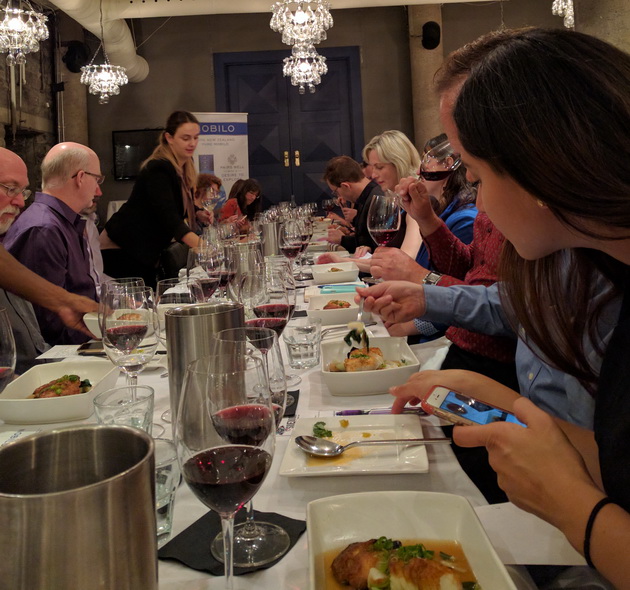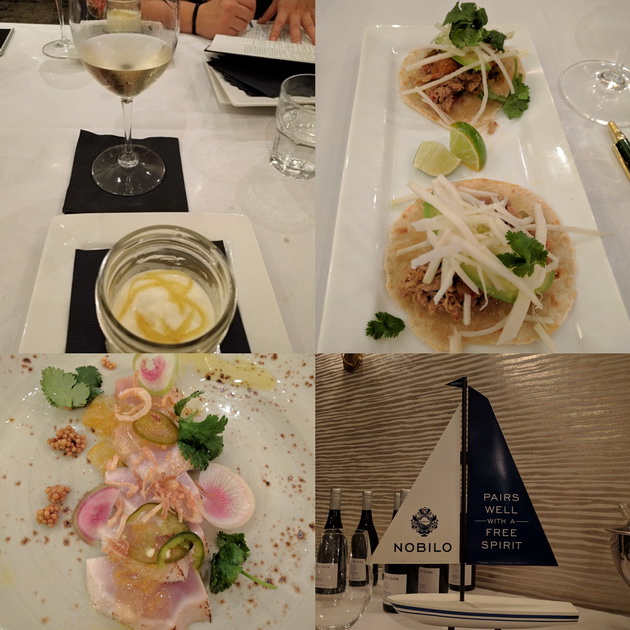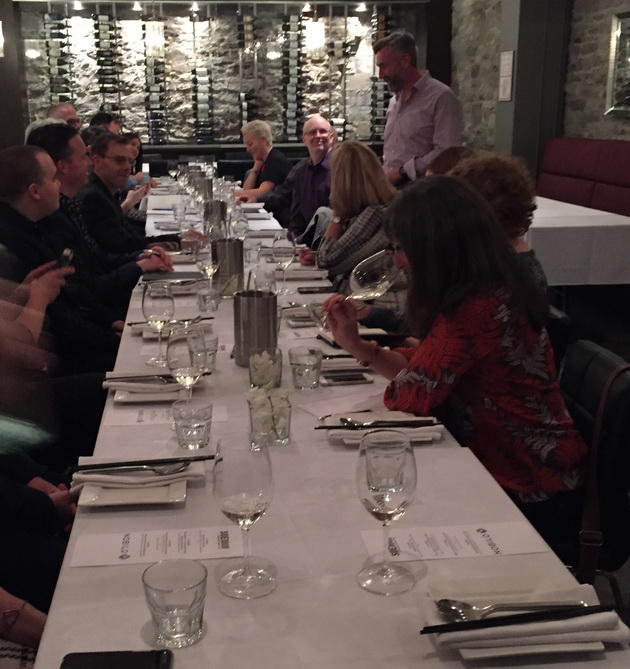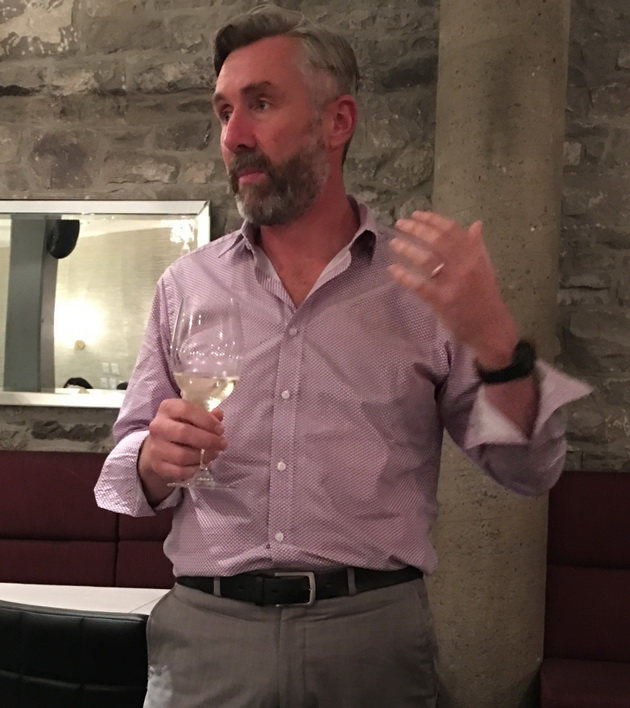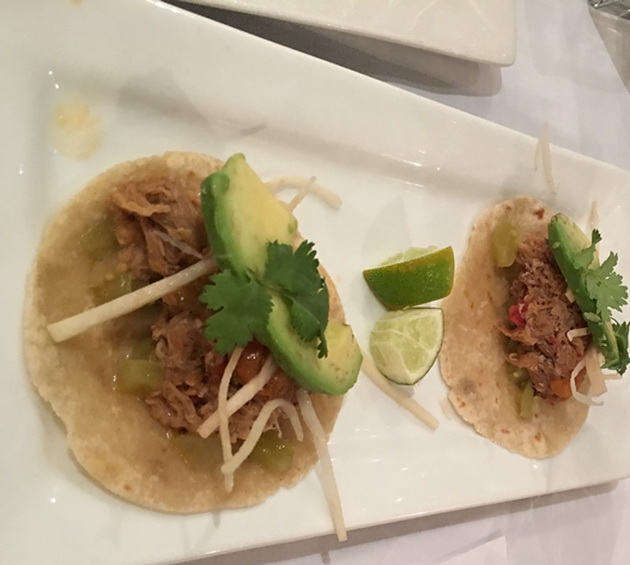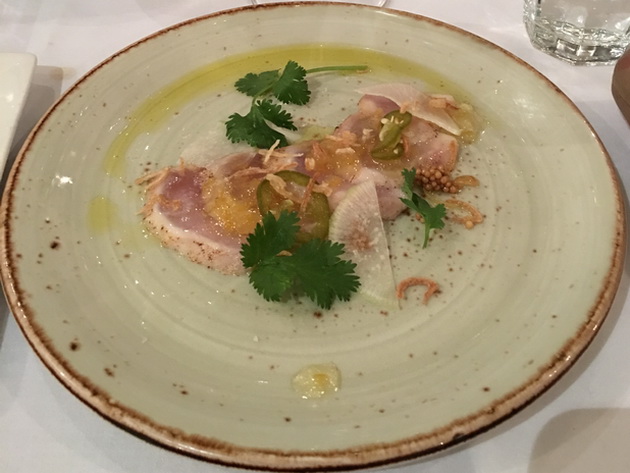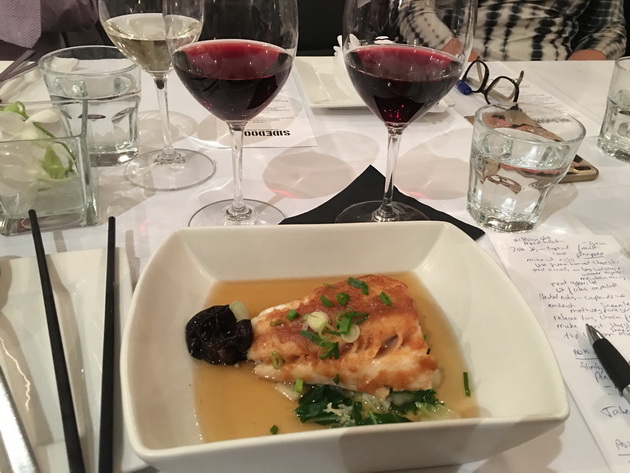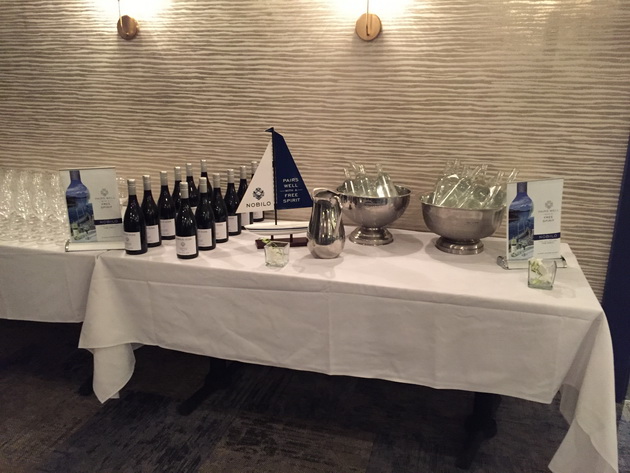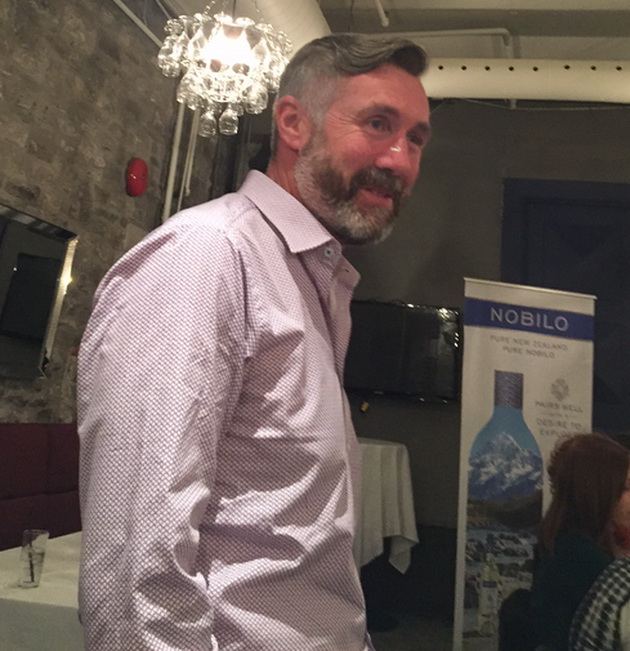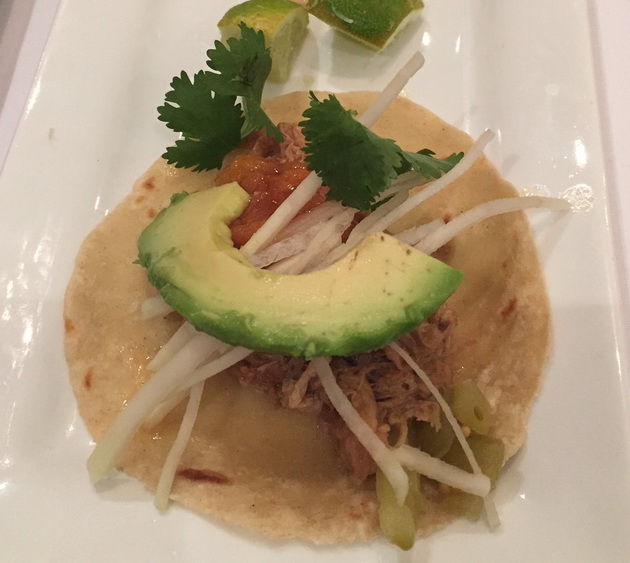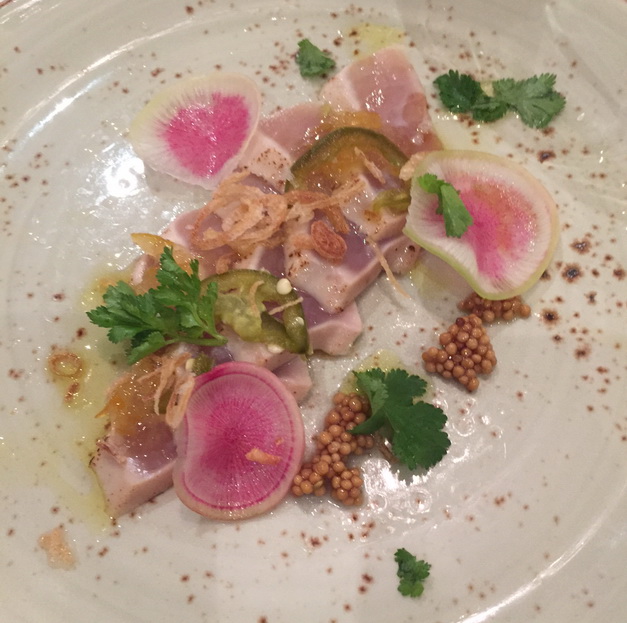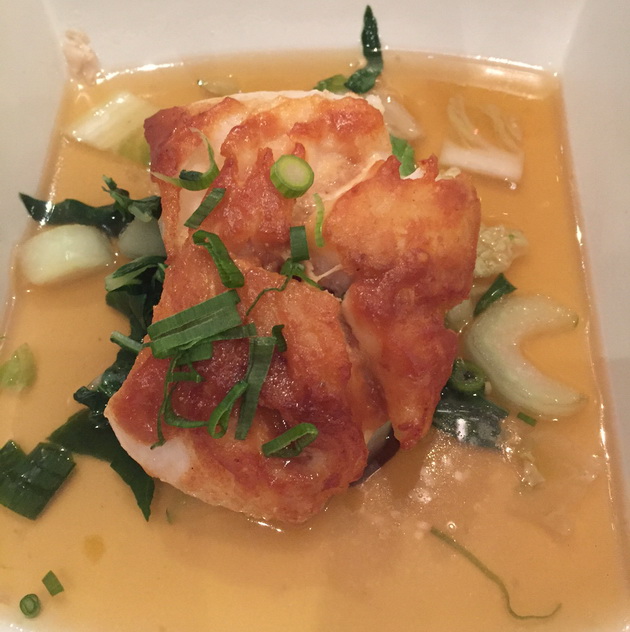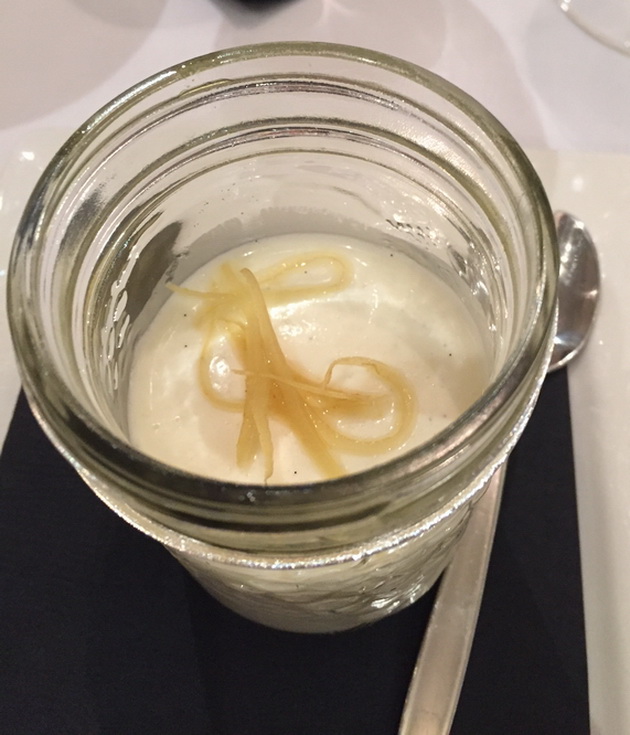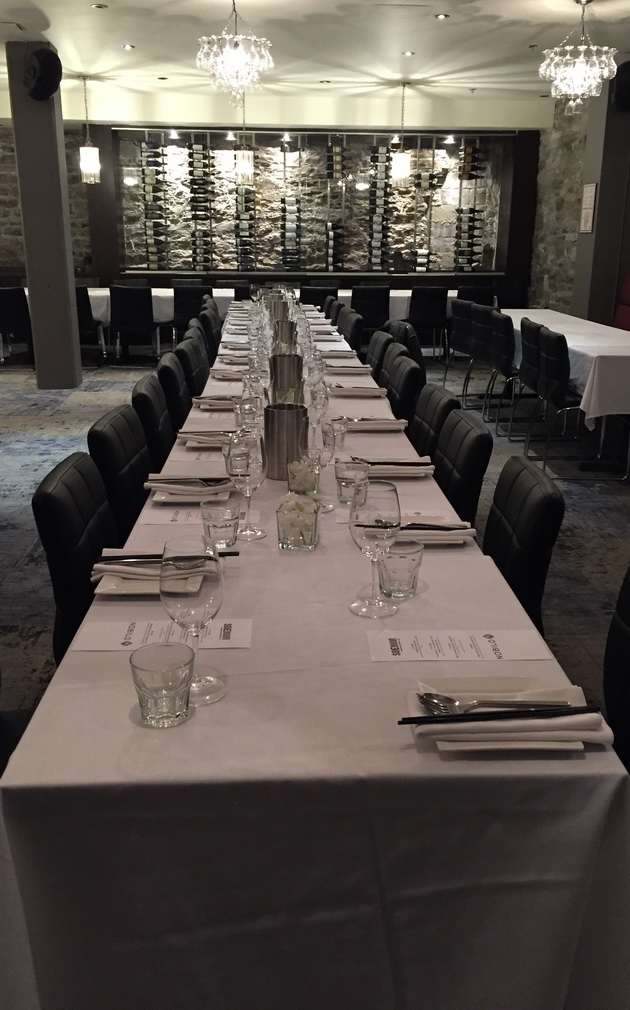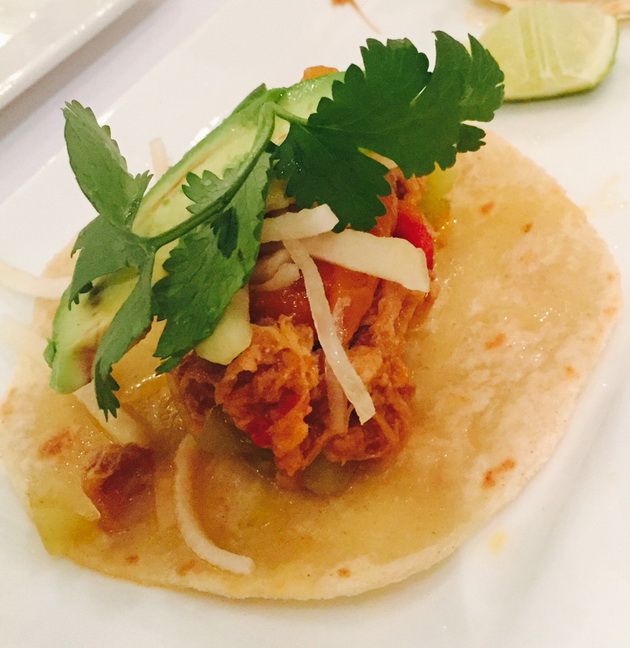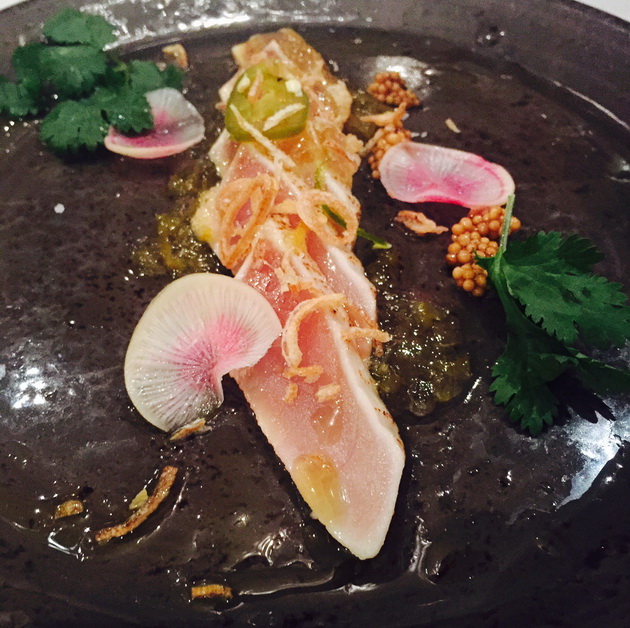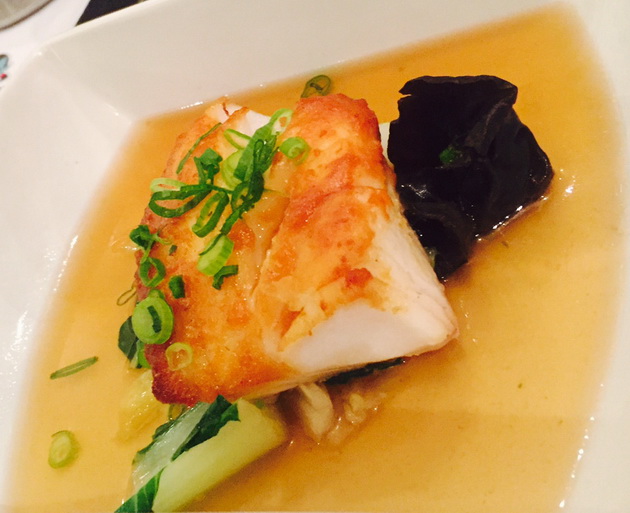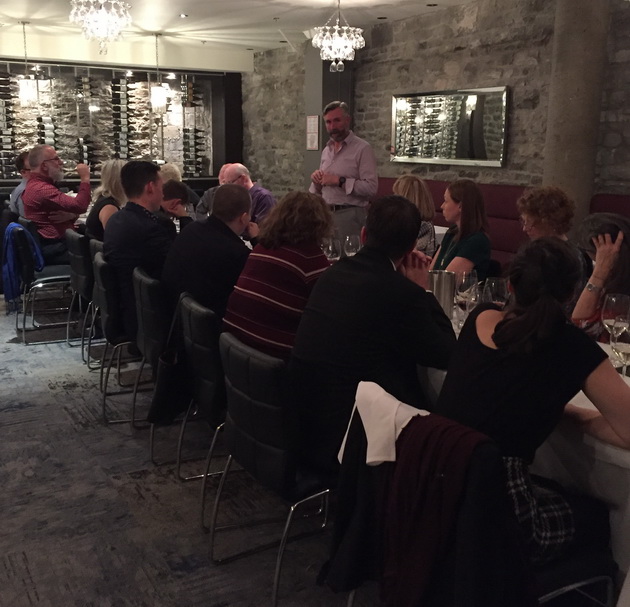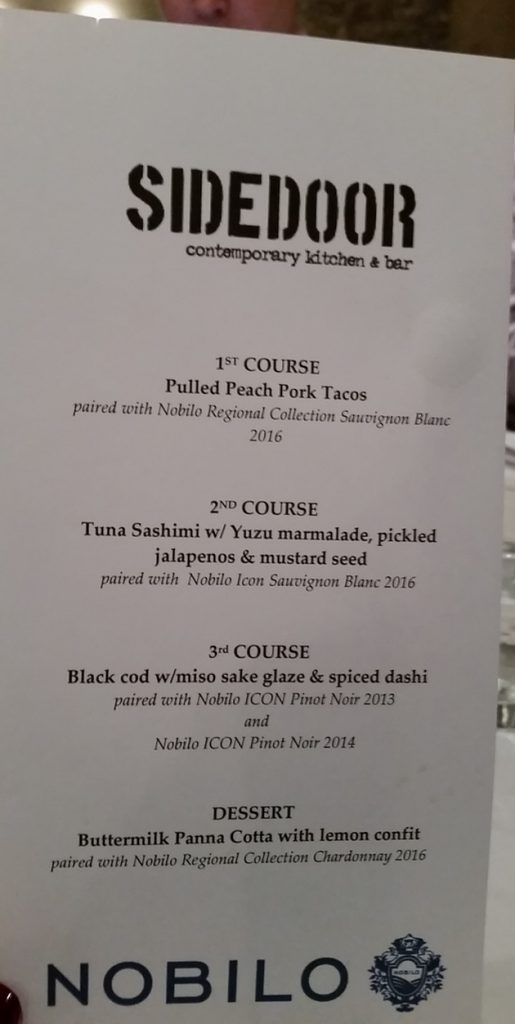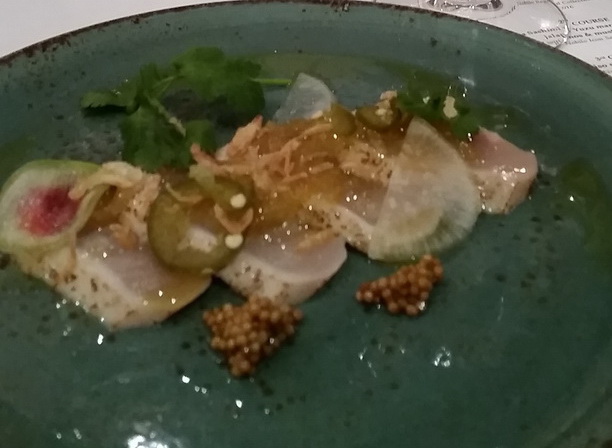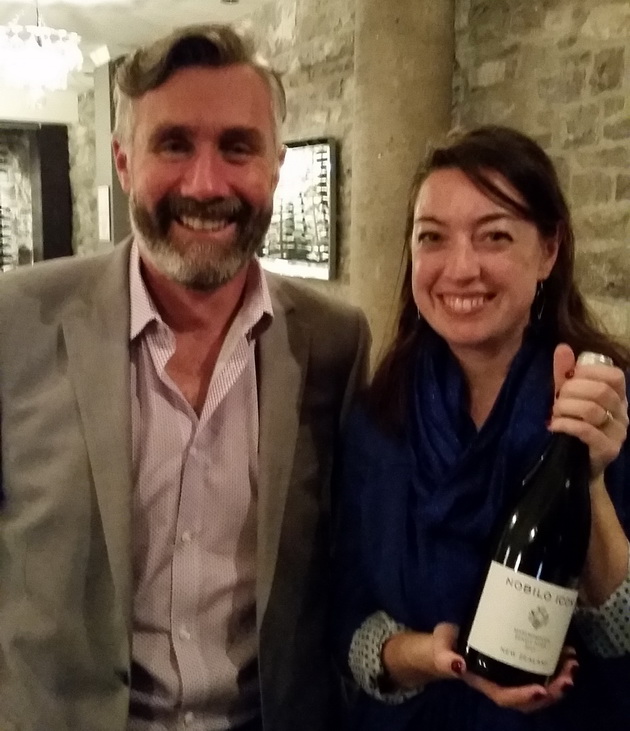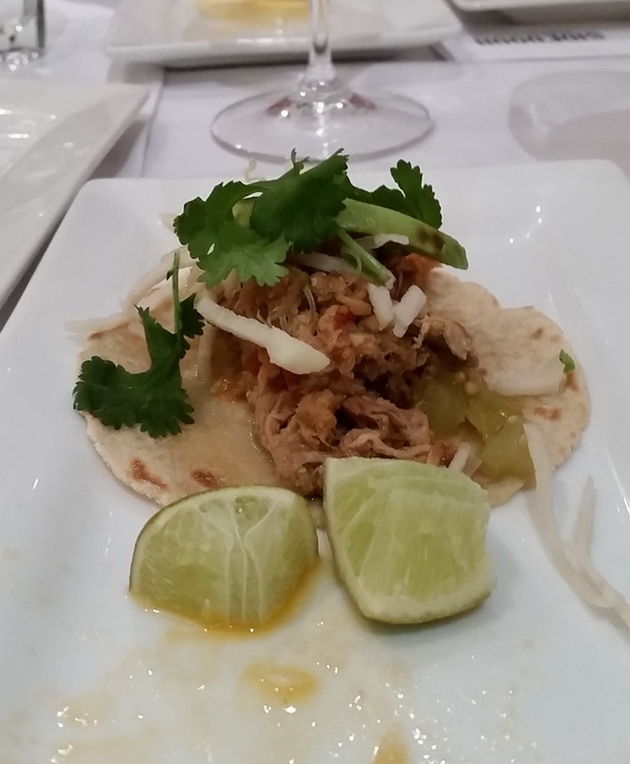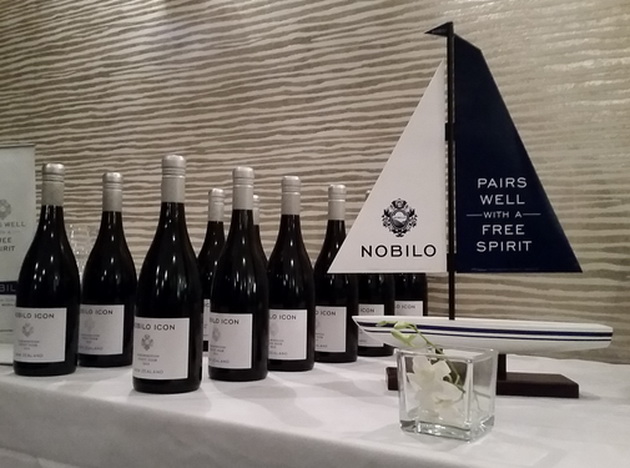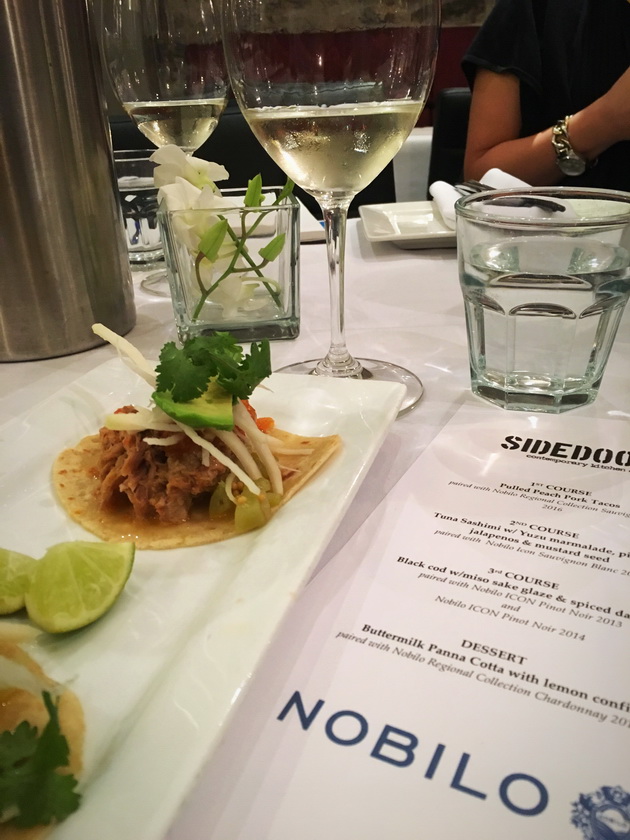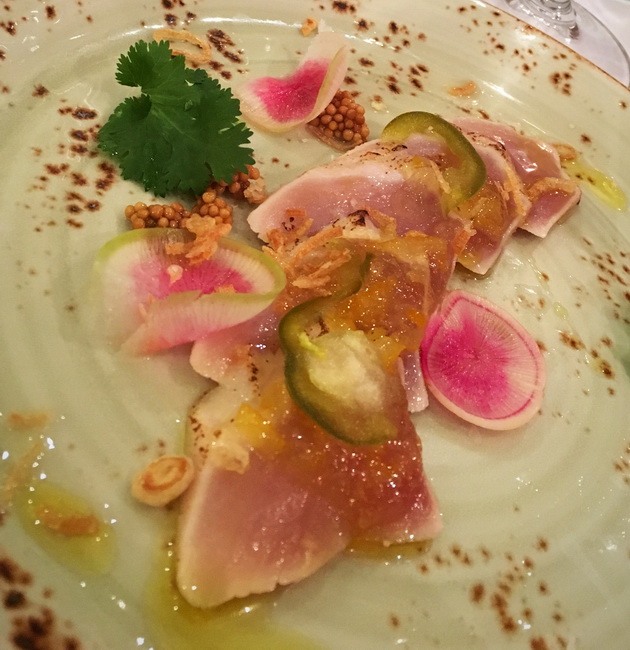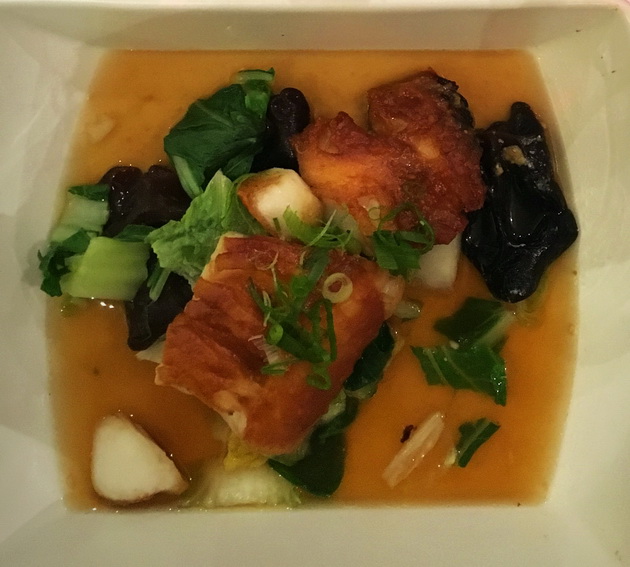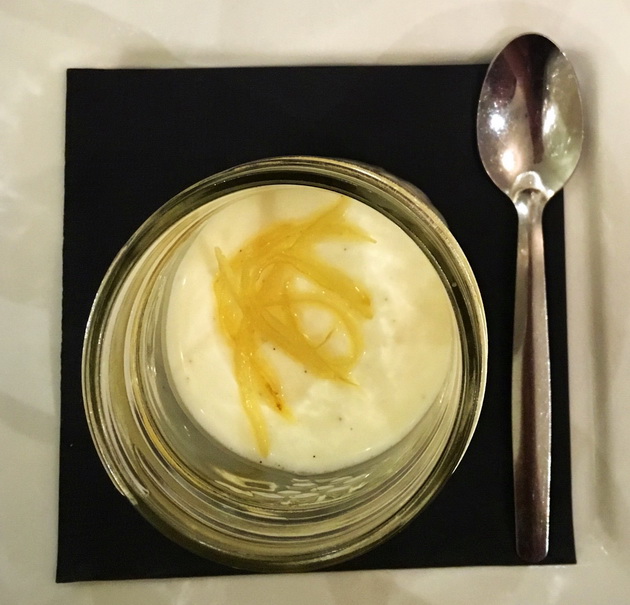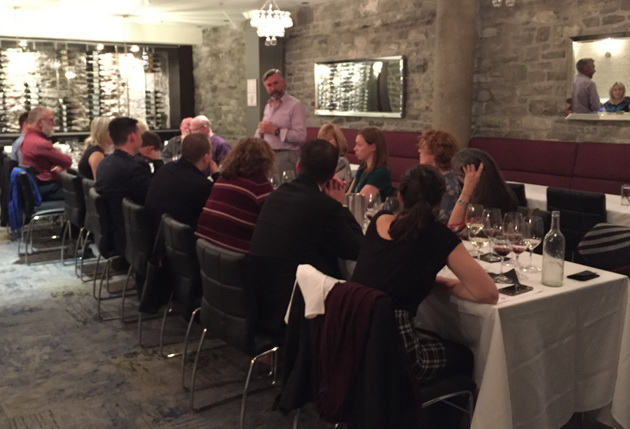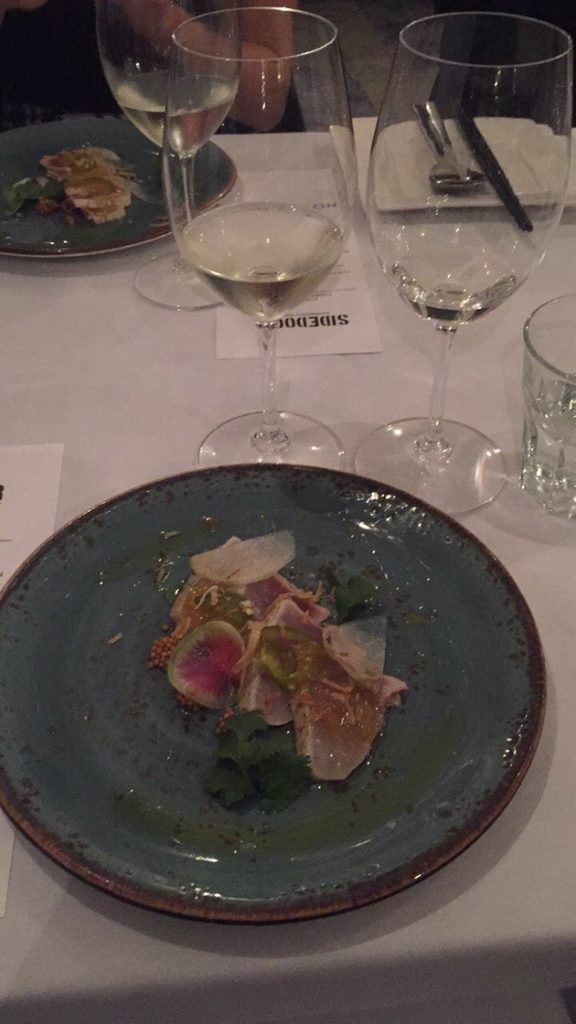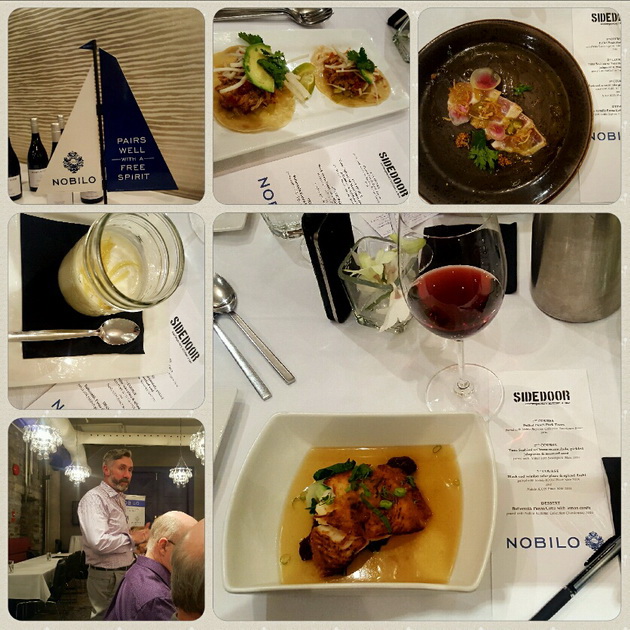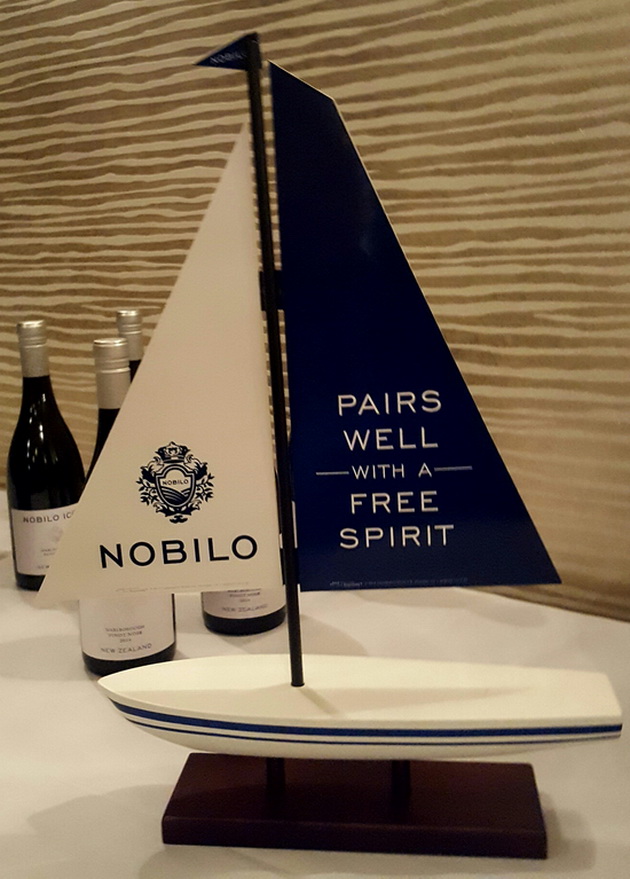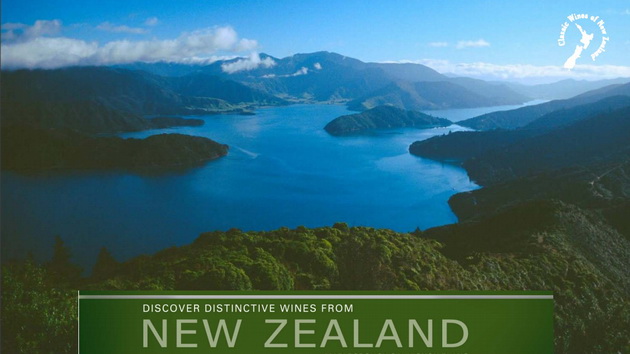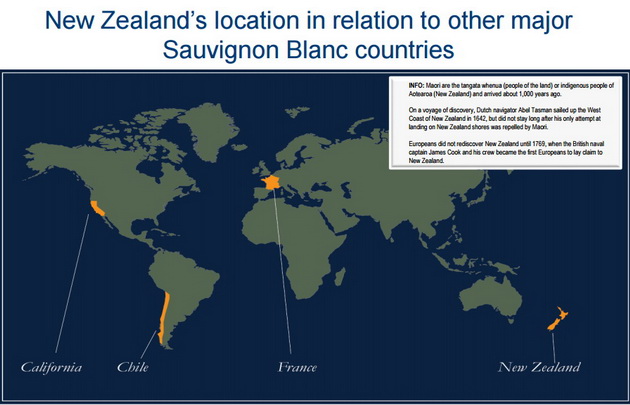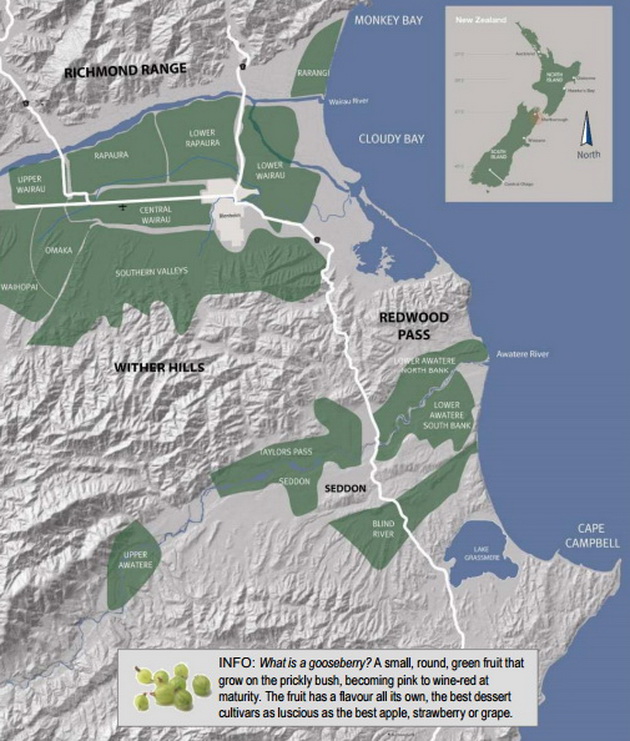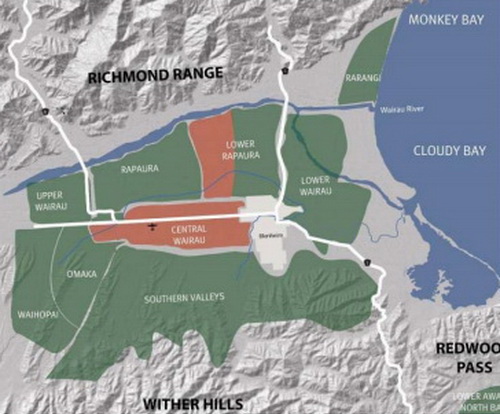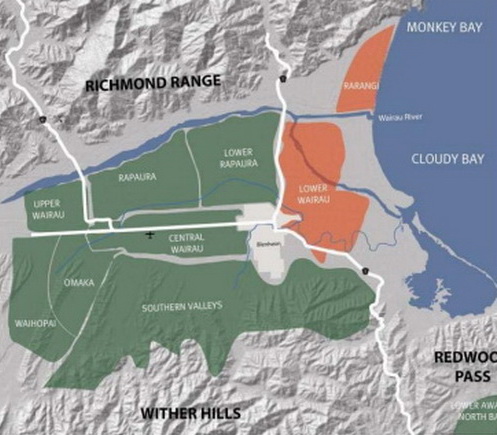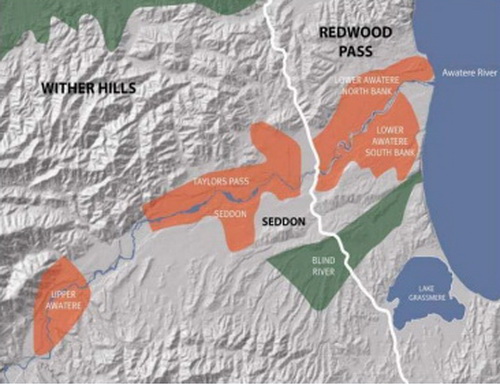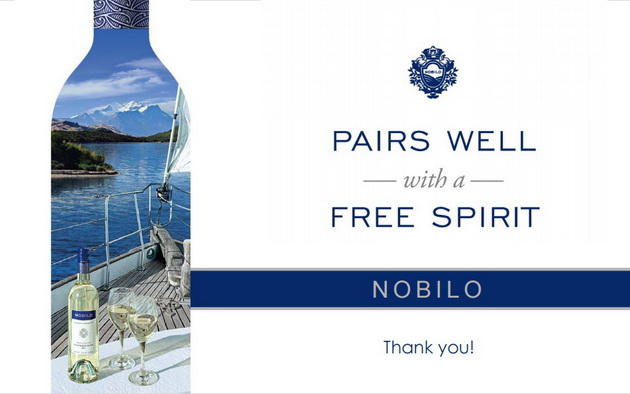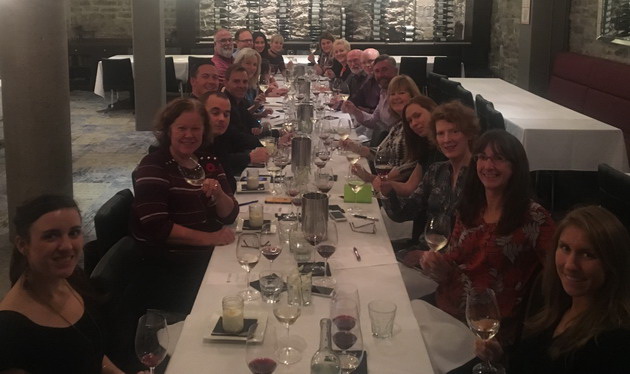Heather Wall
Wine Columnist, Huffington Post Canada
A big KIA ORA Welcome was on hand for Dave Edmonds as he rolled through Ottawa for another stellar tasting of Nobilo Wines of New Zealand. More specifically, Marlborough, easily becoming one of the great wine-growing regions of the world – just ask Dave!
Clean crisp air, oodles of sunshine, cool ocean breezes and volcanic soils cultivates grapes bursting with juicy crispness and zesty, flinty minerality.
Dave came armed with Sauvignon Blancs from both the Nobilo Regional Collection and the Nobilo ICON Collection. Two Pinot Noirs from the ICON Collection and a 2016 Regional Collection Chardonnay.
SideDoor Contemporary Kitchen did a splendid job as usual pairing contemporary plates with the wines such as Pulled Peach Pork Tacos and Nobilo Regional Collection Sauvignon Blanc ’16. The peachy aromas and flavours were brilliantly “pulled” from both the wine and the dish – a perfect union.
My favourite pairing course was the Black cod with miso sake glaze and spiced dashi with Nobilo ICON Pinot Noir ’13 and ’14.
This was an interesting side-by-side lesson on aging and palate preference.
I loved both Pinots sipped on their own but I confess to being a Pinot Noir lover. When paired with the cod I loved the 2014. The salty tropics of the miso glaze accompanied with slight greasiness was a win with the more youthful, juicy fruit spirit of the 2014 Pinot. My palate is definitely more New World.
Others at the table of 12 or so preferred the 2013 with that particular dish.
These winemaker lunches always educate me on the subjectivity of wine palates! Palate preferences around the world is NOT lost on winemakers like Dave Edmonds – tough job in a world that seems to be getting smaller and smaller and consuming more wine.
The Regional Collection Chardonnay ’16 was bright, crisp and tropical with some flinty minerality. Dave admitted he was going “out on a limb” pairing it with Buttermilk Panna Cotta with lemon confit. Each separately were lovely on their own. Together they weren’t terrible but not my favourite.
I think a creamier Chardonnay would have held up better next to the buttermilk.
Which brings us back to the subjective qualities of wine tasting – others thought this a nice match.
We all can agree that lunch with Dave Edmonds and his Nobilo wines at SideDoor Kitchen was a perfect match and we hope he will visit again next year.
Jane Staples
Wine Columnist, Ottawa Wedding Magazine
A wine tasting lunch with my wine colleagues is always fun, especially on a dreary, wet November day. Good wine paired with great tapas and an informative discussion about the wines will brighten the day right up.
On Nov. 3, Nobilo Wines from New Zealand hosted a delicious wine tasting with their winemaker, Dave Edmonds.
Dave knows how to present enough information to be educational without being overly academic and he paces his presentation at just the right speed. The New Zealanders feel that they share a lot in common with Canadians, as he pointed out with a very witty and currently relevant opening remark about our neighbours.
To start, we compared two different styles of Sauvignon Blanc.
We sampled the Regional Sauvignon Blanc 2016, with its tropical and peachy notes paired with Pulled Peach Pork Tacos. The juicy acidity made for an excellent combo and we decided that this wine could also work well with Thai food or as an Aperitif.
We learned that the crisp, mouth-watering acidity in this wine occurs naturally due to the Maritime climate in Marlborough.
Next, the Icon Sauv Blanc 2016 was tasted with Tuna Sashimi, dressed in Yuzu marmalade and pickled jalapenos. Once we figured out how to pronounce this one, we were convinced that the fresh grapefruit flavours and flinty minerality in the wine suited the earthy texture and flavour of the tuna. The mouth-watering acidity could also pair well with oysters.
Then we enjoyed Black Cod with Miso glaze and spiced dashi. Both the 2013 and 2014 Icon Pinot Noirs that we sampled paired well with this scrumptious dish. I was pretty distracted by just how delicious this style of cod in broth tasted, but after repeated bites and sips (purely for professional reasons, of course) established that I had a slight preference for the 2014 with its fuller aromas and flavours.
With its phenological ripeness, it was more chocolatey and showed more ripe fruit than the 2013. Okay, that was the new wine lingo that I learned and it basically means in layman’s terms, that the wine smelled and tasted riper. Sort of like comparing a 30-year-old attractive woman with a gorgeous 50-year-old…both exciting, but maybe the 50-year-old is sweeter and has more to offer…
I glanced at the menu and was delighted to see dessert listed: Buttermilk Panna Cotta with Lemon Confit. This was paired with Nobilo Regional Collection Chardonnay 2016; a very smooth Chard with lively acidity showing a mild tropical nose of pineapple, mangos and touch of lime, and lots of vanilla on the palate.
There’s no question that Nobilo wines deserve their international acclaim. Certainly their intensity and complex flavours have enchanted my own tastebuds. My ongoing love-affair with New Zealand wines continues.
Cheers to Nobilo!
Jennifer MacDonald Havers
Wine Columnist, Ottawa Citizen
Our tasting group was lucky to have met Nobilo winemaker, Dave Edmonds last summer, and got an introduction into his philosophy and techniques around winemaking.
Meeting him again, a year later, we get to build on that knowledge, get a sneak peek at the new 2016 vintage, and as well, try some unusual food and wine pairings with some of his signature wines.
2016 was a great vintage, with a cool spring that helped to slow down final ripening before the harvest. The result is some well-developed flavours.
Similar to what I’ve learned from other New Zealand winemakers, there is a lot more diversity to Sauvignon Blanc than many of us ever think about. Dave relies on wine from specific vineyards to impart different flavours, e.g. more tropical notes like guava and pineapple from Wairu, or more flinty, mineral notes from the cooler Southern Valleys.
Each vineyard contributes to the overall character, and the Icon and Regional Collection demonstrate the diversity of styles that can be created.
We started with their newest Regional Collection Sauvignon Blanc from 2016 (the Canadian Premiere!) as an aperitif to get the mouth watering. Using Sauvignon Blanc in this way before a meal is a great idea, it works well to wake up your palate and would be a great alternative to a cocktail or bubbles when hosting a dinner party.
We contrasted this with the Icon Sauvignon Blanc that had more of that minerality (that I love!). These perfectly complemented the dishes we were served, pork tacos with peach with the Regional Collection, and tuna sashimi with the Icon.
It was clear that Dave the winemaker had provided a lot of insight into the day’s lunch menu. He seemed to have personally vetted each pairing and walked us through them with a lot of passion.
The highlight for me was the pairing of the two Pinot Noir (2013 and 2014) with a dish of black cod with a miso sake glaze and spiced dashi. While many people avoid pairing white fish with red wine, this is a case where the flavours surrounding the fish made the pairing.
The spicy and briny nature of the broth worked beautifully with the earthy, slightly gamey notes in the Pinot Noir, particularly the 2013. It worked so well together and I would recommend for anyone to try it.
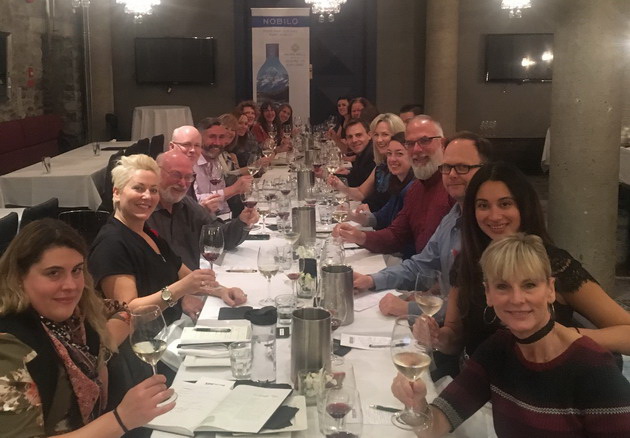
Craig Kuziemsky
MBA Professor, University of Ottawa & Sommelier
On November 2 we were treated to a wine tasting at Sidedoor restaurant with Dave Edmonds, winemaker at Nobilio winery in New Zealand.
It was a wonderful event where I learned some fascinating insights about Nobilo wines.
Foremost is that while Sauvignon Blanc, New Zealand’s most prominent varietal, is often associated with gooseberry and fresh cut lawn. Nobilo purposefully produces a Sauvignon Blanc without those notes.
Dave provided a very scientific explanation that included a lot of organic chemistry about green leaf volatiles and long chain fatty acids. The net effect is the production of a Sauvignon Blanc with crisp notes of tropical fruit and citrus.
Both the 2016 Regional Collection and Icon Sauvignon Blanc had crisp tropical fruit notes. The regional collection had some added mineral and lime notes while the Icon had flinty notes with a wonderful aroma and flavour of pink grapefruit.
The Sauvignon Blancs paired well with courses one and two, peach pulled pork tacos and tuna sashimi with yuzi marmalade, pickled jalapenos and mustard seed. The Icon Sauvignon Blanc in particular, was a great pairing with the pickled jalapenos.
The third course was black cod with miso sake glaze and spiced dashi paired with the Nobilo Icon 2013 and 2014 Pinot Noir.
The two Pinot Noirs were very different. The 2013 had largely dark fruit flavors with some cherry and earth notes. The 2014 was a much more fruit forward Pinot Noir with notes of sweet cherry and cola. The 2013 Pinot with its dark fruit and earth notes was a better pairing for the cod.
Dessert was a buttermilk panna cotta with lemon confit, paired with a 2016 Nobilo Regional Collection Chardonnay. The chardonnay reminded me of a Chablis as it had tropical and stone fruit notes with a touch of green apple. All in all, a great afternoon of wonderful food and outstanding wine.
David Skinner
Wine & Travel Columnist, Outdoor Magazine
Complex and sophisticated. Dynamic character and plenty of depth.
While those may be terms to describe the wines of Nobilo, they most certainly can be applied to their wine maker, David Edmonds.
His passion for turning well-selected grapes into perfectly crafted wines is practically written on his face, but listening to him speak, you completely understand how he has managed to infuse this enthusiasm into his craft.
Tasting five offerings from the Nobilo line, paired with four small plates from the Sidedoor restaurant, showcased just how the versatile Marlborough style can enhance the total tasting experience. A pulled peach pork taco with the Regional Collection Sauvignon Blanc from 2016, kicked off the tasting and was the perfect union of sweetness and acidity, stone fruit and tropical flavours, along with a great textural contrast.
The highlight for many of the sommeliers in attendance, was the tuna sashimi with yuzu marmalade, pickled jalapeños and mustard seed, served with the 2016 Nobilo Icon Sauvignon Blanc. The elegance and grace of the wine amplified all the spice, umami and sweetness in the dish while boosting the passion fruit and minerality in the wine.
This is what pairings are all about. Finding the match that elevates both the food and the wine to heights greater than their individual contributions.
In describing the Icon, David remarked that the aromas were absolutely “crawling over the sides of the glass” and indeed the intensity of these Blind River grapes was perceptible even before the glass was lifted from the table.
Although the word iconic is annoyingly overused in virtually every piece of writing and conversation, it’s a perfect fit for this benchmark New Zealand varietal. Full of passionfruit, gooseberry and an elegant minerality that David compares to “lightning in the distance coming across in the breeze”; this is truly a wine that sets the standard for excellence.
Nobilo has ambition as well as laurels and they are experimenting with alternative ways to make Sauvignon Blanc and other varietals into different styles and hopefully adding new layers of character to their future offerings. By varying techniques such as hand picking versus mechanical, whole bunch or crushed fruit, old barrels and new or introducing different yeasts, the hope is to gain knowledge that will lead to continuous improvements and new experiences.
One such experiment led to the creation of their 2016 Regional Collection Chardonnay.
This chardonnay was served with a buttermilk panna cotta and lemon confit. While some felt the dessert coated the palate too much thereby muting some of the wine’s character, the wine on its own was delicately designed to be stylistically like Sauvignon Blanc. To achieve this profile, the fruit was crushed, destemmed, and direct pressed with no skin contact.
The clarified juice was fermented at cool temperatures and approximately half of the wine was fermented and matured in French oak, either new or up to 3 years old, with very little malolactic fermentation. This made for a crisp style of chardonnay that was driven by tropical notes of mango and pineapple accented by a slight citrus presence.
The 2016 vintage offered some challenges to the Benheim-based wine makers. A cool start to the year in October and early November 2015 yielded a tardy bud break but a dry summer followed that was ideal for the vast acreage of Sauvignon Blanc cultivated in the northern valleys of the South Island.
Late rainfall made for a very hectic but productive harvest with all the fruit arriving at the wineries at once. The Edmonds team was up to the challenge and had grapes fermenting in quick order. The rainfall didn’t impact the fruit quality and the ideal summer conditions started to express themselves immediately under David’s hand.
Moving away from the most recent vintage, the group was treated to a black cod with miso sake glaze and spiced dashi set against a backdrop of the 2013 and 2014 Icon Pinot Noir.
The 2013 is already showing some of that aged character of mushrooms and forest floor while its younger sibling expressed a more fruit-driven profile. The 2014 was a better match to the cod given the very salty nature of the dish. Perhaps a mushroom-based delicacy would have been more suitable to the 2013 version.
The delicate grape needed to make this graceful wine, finds a perfect home on the South Island of New Zealand and while the Central Otago region gets lots of attention, the pinots from Marlborough should be respected as well.
Given the immense focus on Sauvignon Blanc in this area, it makes sense that any pinot noir that has been retained over the years would have to be very special. And when it is treated with care, this grape can be spectacular in maturity.
Mr. Edmonds explained that even the punch-down of the cap during fermentation was particularly gentle for their Pinots. By using puffs of nitrogen rather than mechanical means to break up the cap, the inert gas simply moves the solids without otherwise impacting the wine. This process is colloquially called the doof-doof method by the workers tending to the fermentation.
It’s clear from this tasting that Nobilo Wines has a great ambassador in their head wine-maker, David Edmonds. Moreover, his focus on quality and innovation promises to yield great wines now and in the future.
Doug McMillan
Accredited Sommelier & Blogger
We’re a very luck bunch to get to attend events like this. They’re social, informative, and extremely tasty. There’s the wonderful wines and foods of course, but also the conversations.
How often do you get the chance to discuss the wine you’re making from grapes in your back yard with a world class winemaker?
The level of detail shared with us on the various aspects of geology, and bio-chemistry is amazing; this is no longer an occupation that is just passed down from parents to children at this level.
The education required to make the best wines possible is startling. I’d never have assumed that there was a relationship between the volatile organics that produce onion and garlic aromas and those that give that beautiful cut grass or cucumber aroma.
Apparently, they’re working on enhancing some of the aromas by stressing the yeasts, making them work harder to convert the sugars. Like the growing of grapes, even the yeasts seem to do better work when under pressure, sort of a wine version of “tortured artist syndrome”.
Along with the conversation was a great bunch of very approachable wines, paired with fantastic dishes by SideDoor restaurant. These events normally have very good food, but rarely do the pairings go so well.
The first two wines were Sauvignon Blancs, and the second one, paired with a Tuna Sashimi was incredible. The first was very good as well, tying in very nicely with the cilantro in the pork dish.
I was surprised to hear the prices of these wines, as they definitely punch above their weight. Although I didn’t taste them side by side with more expensive wines, I’d certainly give them a good chance at coming out well against more expensive competitors, certainly while paired with the specific dish with which we tried them.
Greg Hughes
Sommelier & Blogger
We began with the Regional Collection Sauvignon Blanc from new 2016 vintage. This vintage was short and yielded good quality, but began with a cool spring. That can be troubling for the buds – affecting crop levels.
Nobilo produces from all over Marlborough, from Wairau and Rapaura, Lower Wairau, and Rarangi. Rather than simply sourcing (buying grapes vintage by vintage), they actually invest in purchased land and develop it. They have more control over how the grapes are grown and handled.
Aromatics have a lot of lemon juice, guava, vanillin, pineapple, grapefruit, and nectarine with floral aromatics of orchard blossom. Good acidity (all natural), soft and pure tasting.
Side door paired it with pork tacos. Thai food, in New Zealand, is a favourite pairing for the style of wine he makes.
Dave proceeded to discuss leafy volatile aromas; about managing picking and fermentation to mitigate this. Pyrazines.
He also discussed the encouragement of thiols, by introducing certain compounds when the yeast struggles. Challenge them with temperature and moisture to encourage thiols?
Second wine is the Icon Sauvignon Blanc 2016. This is Dave’s baby – there is a wild, flinty character that apparently came from the heavy sourcing from the Blind River. Dave favours Blind River, having gone in early to ensure Nobilo gets property in there.
While all of their Sauvignon Blancs have lovely acidity, it’s apparent Blind River delivers very unique structure – it builds out the mouthfeel. It’s more substantial, but less glitzy at Wairau Or Rarangi.
It was paired with tuna sashimi, yuzu marmalade, and pickled jalapeno/mustard seed. The tuna was amazingly well cooked. The pairing goes especially well with the mustard seed.
A lot of what’s on the plate tunes out the palate of the wine, but the acidity refreshes.
Nobilo does practice a certain amount of playing around with style and practice, to learn what they can from the varietals they focus on. Would new wood overpower NZ Sauv? What does wild yeast taste like, on top of Sauv and Pinot. He never thought the new wood was going to work, but it has. They’re playing with toasts, at the moment. He prefers Allier oak, apparently.
Black cod, in a dashi (mummified fish) broth with a mini horizontal of Icon Pinot Noir from wp13 and 14 was the third course. The umami really works with the Pinot.
When chewing on the Pinot grapes, if they have to be spit out because they’re really harsh or astringent, it isn’t ready on the vine. When it is ripe and you can chew them a lot without it being distasteful, it is good and phenolically ripe.
He mentions how his team has innovated with a doof-doof – apparently, a device used to break the cap, during punch-down.
2014 Icon Pinot is velvety, soft, and full of ripe cherry, and anise. There’s a distinctive lanolin character. Lots of blueberry and cherry on the palate as well as lilac and rubber.
2013 Icon definitely has developed some forest floor, gaminess, mushroom, burnt sugar, smoke, all on top of the cherry, boysenberry, and blueberry. Rosie. Tannins are incredibly ripe.
The last wine is the Regional Chardonnay 2016. It tastes somewhat like a Chardonnay treated like an anaerobic Sauv Blanc. It is incredibly pale.
The flavours are super subtle. It’s Marlborough – so citrusey. It was marketed to Sauv Blanc lovers.
In Marlborough there are a lot of large cobblestones – the soil can get quite rocky. Marlborough combines stony ridges and silty hollows. Placing their Chardonnay plantings up high, where the sun can get into the grape and where the heat can radiate off of the rocks gave it this fruity tropical ripeness.
They tried to plant this Chard somewhere where it replicated the pineapple of their Sauv. Malo is blocked. No oak. They tank it.
The anaerobic Chard tastes like papaya and nectarine. I am glad it exists, but what do you want it to be? What is the future of this wine?
They’ve only made it for two vintages. Experimentation is good, but what can be learned and improved upon?
What makes a Chardonnay made like this taste this way? Are they simply trying to replicate Sauvignon Blanc flavours in a Chardonnay or are they trying to see what a Chardonnay does when it is treated like their Marlborough Sauvignon Blanc?
Either doesn’t necessarily preclude the other, but it would be more interesting to see a Chardonnay done this way that is still definitively Chard.
Gwen Barton
Certified Sommelier
Before attending the Nobilo event, I took the opportunity to review their website.
The scenes of the Marlborough Region, the rivers and hills of the Wairau and Awatere vineyards and the tasting videos by our event’s host, David Edmonds – set the stage nicely for what to expect.
The event was billed as not only sampling Nobilo wines, but also pairing these with unusual choices – we weren’t disappointed. My favourite wine and pairing of the day was the 2016 Sauvignon Blanc (Nobilo Regional Collection) with the pulled peach pork tacos.
I found the wine’s crisp acidity and generous aromas of tropical and stone fruit complemented the dish. In my mind, this was largely credited to the peach chutney which pulled everything together.
The fruit notes of the wine were very prominent and easy to find, although I was able to detect hints of vegetal and herbaceous notes which I usually associate with sauvignon blanc.
The vertical tasting of the 2013 and 2014 ICON Pinot Noir allowed us to comment on the differences between the two. Both went very well with the black cod with miso sake glaze.
The paring brought out the mushroom, fungi and forest floor notes of both wines. I found the fruit notes in the 2013 to be more dark cherry and stewed strawberry, while the younger 2014 had more blackberry and hints of cocoa.
This was a very enjoyable tasting event. Sidedoor is a great venue and our host, David, was a master at sharing (and transferring) his excitement and passion for these lovely New Zealand wines.
 Jon Steeves
Jon Steeves
Accredited Sommelier & Blogger
As part of Natalie MacLean’s National tasting team, I enjoyed a bespoke structured tasting of five Nobilo wines from Marlborough New Zealand, lead by Chief winemaker Dave Edmonds at Sidedoor Kitchen in Ottawa’s market district.
It had been a year since our team had experienced the Nobilo portfolio from the 2015 release.
Dave shared his passion for the terroir and the fruits of the Nobilo team’s labour along with an interesting history lesson about the “winemaker’s baby”, the Nobilo Icon Sauvignon Blanc and the Nobilo relationship with wine innovation, research and development as Dave and his winemaking team seek novel approaches to blending.
Dave’s approach to Viniculture is part art, part science and full of passion. Collaborating with experts in the field of wine aromatic research, “making the yeast suffer” to produce novel wines, releasing long chain fatty acids into six Carbon chain alcohol to enhance elements of cucumber and cut grass in the aromatic profile.
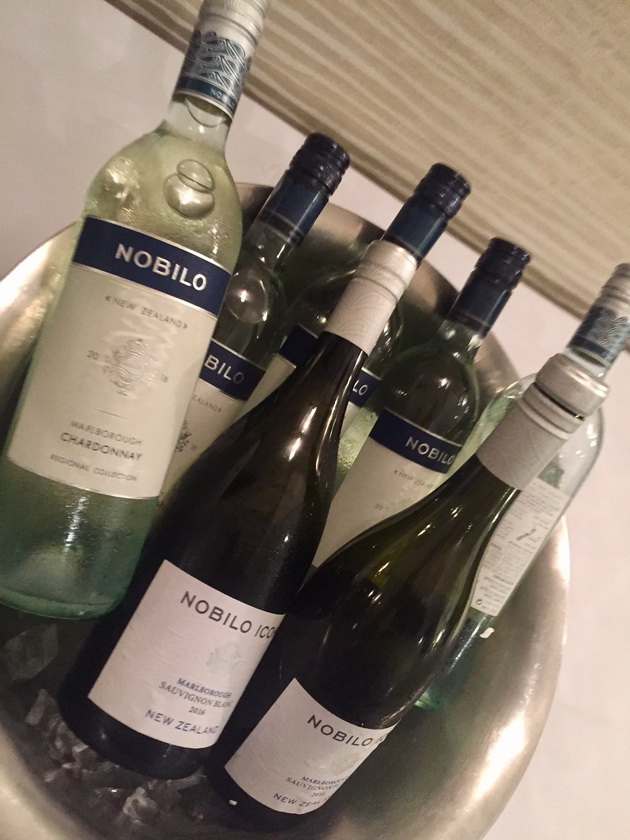
The wines were delicious, including a vertical of the 2013 and 2014 Nobilo Pinot Noir, 2016 Chardonnay, 2016 Sauvignon Blanc, and the 2016 Nobilo ICON Sauvignon Blanc. Tastings verticals is a passion of mine.
I was impressed with the slight differences between the wines of different vintages and the variation in complexity between the 2016 Nobilo ICON Sauvignon Blanc and 2016 Nobilo Regional Collection Sauvignon Blanc.
In terms of viticulture, Dave shared how his team uses the natural contours of the land to enhance components of the fruit and integrate diversity into the wine. For example, stony ridges and hillsides with less leaf coverage to enhance fruit access to sunlight and reflecting heat from obsidian stone ground cover likewise, with intention to influence the grapes.
Mary Anne Van Gaal
Wine Tasting Club Leader
I think the most interesting piece of trivia I learnt was how the winemaker can tell the grapes are ready for producing Pinot Noir….he chews on the grape for several minutes until the seeds explode, then he knows they are ready!
I also learnt that dry, almost drought like summers are perfect for producing Sauvignon Blanc.
Also, when there are no cool nights, the grapes retain their acidity. And that cut grass aroma is actually caused by compounds called “green leaf” volatiles, not your imagination!
Soil type has an impact not only on mineralogy, but on the amount of leaves produced by the vines. Rocky soil limits leaf production, which in turn allows more light and heat to reach the grapes evolving into pineapple and mango flavours and a deeper colour.
Matt Steeves
Wine Expert, CTV Morning Live
A group of Ottawa-based wine writers and sommeliers had the pleasure of spending a few hours with Dave Edmonds, the winemaker at Nobilo, to taste his latest works of art, including the Canadian premiere of his 2016 vintage Regional Collection Sauvignon Blanc and Chardonnay, and the 2016 vintage ICON Sauvignon Blanc, which should all be on the shelves of Canada’s finest wine shops in the coming months.
As Dave noted, the 2016 vintage was a stellar one for producing low yields of complex fruit as the cool spring and a super dry summer, although challenging growing conditions, had a positive quality impact on the crop which resulted in high quality wines.
Winemaker Dave Edmonds, a native of New Zealand, has been producing NZ wine for many years and is recognized as a leader in premium NZ wine production. Dave spoke about the characteristics of the different Marlborough sub-regions, some of his favourite vineyards, and what each brings to the wines they produce.
Characteristics such as tomato leaf from Awatere, gooseberry from Waihopai, passionfruit and grapefruit from Central Wairau. Understanding the characteristics of each sub-region and incorporating those into the individual wines, year to year, is where Dave excels, and the proof is in the finished products that he shared with us.
Dave poured a flight of their Sauvignon Blanc and Pinot Noir, from recent vintages, and both their Regional Collection and Icon series wines proved true to those characteristics of complex flavour, refreshing, and very well balanced. Essentially, ideal wines to be enjoyed with delicious food, and that’s exactly what we did at Sidedoor Kitchen.
Dave was very humble about the fact that his Regional Collection Sauvignon Blanc is the number one selling Sauvignon Blanc in the USA. Clearly a class leader. I found it delivered everything I wanted it to for that style of wine and at that price point. I awarded this wine 91 pts, which is an exceptional grade for a sub $20 wine.
Tasting the 2016 ICON series Sauvignon Blanc was quite a treat too. Dave doesn’t hide that fact that the ICON Sauvignon Blanc is his baby, and I can totally understand why! Incredibly expressive, with pink grapefruit, passion fruit, jalapeno relish, and wet stone on the note.
The palate is crisp and layered with loads of minerality, lime, grapefruit, and herbal notes. A great palate cleansing wine that’s ideally suited for enjoyment with Asian fusion dishes and seafood. I enjoyed it with Tuna Sashimi with Yuzu marmalade, pickled jalapenos & mustard seed – and wow it was dynamite! Tasted November 2016, at the Canadian premiere of the 2016 vintage. 91 points. Matt Steeves www.quercusvino.ca
We had the pleasure of tasting the 2013 and 2014 Icon Pinot Noir which was great to see the differences in those vintages. The 2013 was more rustic and gamey with prominent cherry, gamey, herbs, and spice, whereas the 2014 was more youthful, with sweet dark cherry, beets, spice, with a fruity and velvety smooth palate that highlighted the sweet spice on the finish. I had tasted both of those wines a year ago and it was nice to witness the evolution that an extra year in the cellar has afforded them.
Next we tried another new release, and this one only the second vintage ever, being the 2016 Regional Collection Chardonnay. This Chardonnay is guaranteed to be a hit for those that enjoy Nobilo Sauvignon Blanc and those that appreciate a lighter style of Chardonnay.
If you haven’t tried Nobilo Sauvignon Blanc, Chardonnay, or Pinot Noir, then I’d suggest picking some up and enjoying it with some good friends. Keep your eyes peeled for the stellar 2016 vintage…you don’t want to miss this one!
If you’re ever in Marlborough, NZ, make sure you check out the pig hunting and Pinot Noir ‘pairing’. Apparently gamey wild pigs are incredible with Nobilo”s Pinot. Worth a try on so many levels.
Melanie Aubert
Sommelier & Blogger
On Thursday, November 3, a select group of Ottawa (wine-os) wine professionals congregated at Sidedoor in the Byward Market for a fantastic tasting event with Nobilo winemaker Dave Edmonds.
As we waited for the main event, we sipped on the 2016 Nobilo Regional Collection Sauvignon Blanc. It was the perfect lunchtime apéritif: lots of tropical fruit like pineapple, mango and passion fruit, as well as apricot, grassy notes, minerality and white peach.
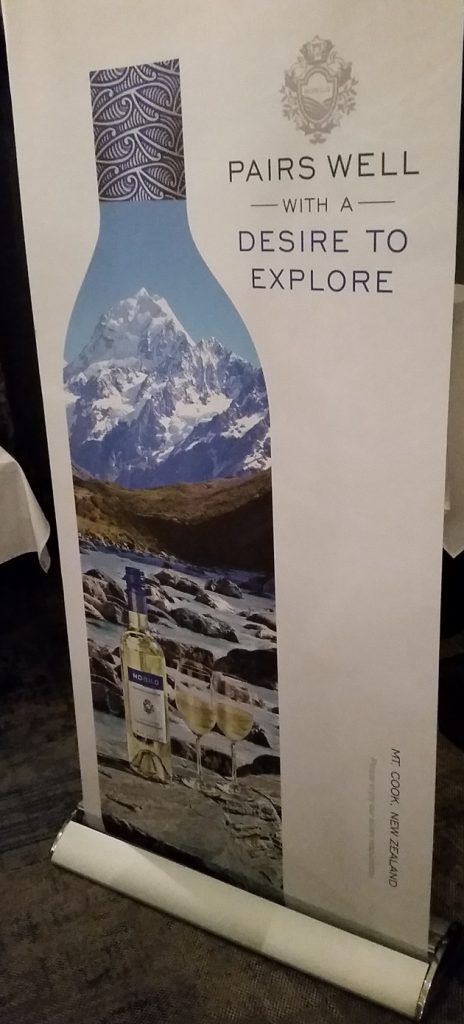
The crisp, refreshing acidity, the hallmark of New Zealand sauvignon blancs, prepped our palates for lunch.
Marlborough’s maritime climate, with the moderating influence of the ocean, offers perfect conditions for creating this telltale juicy acidity. Nobilo sources its grapes from all over Marlborough, and apparently has more vineyards than any other Constellation brand.
The first course arrived: pulled pork tacos with a peach jam. I thought the sweetness of the peaches and the pork complemented the tropical notes of the wine well, but the jalapeño was perhaps not as great a match for the racy acidity of the Regional Collection SB.
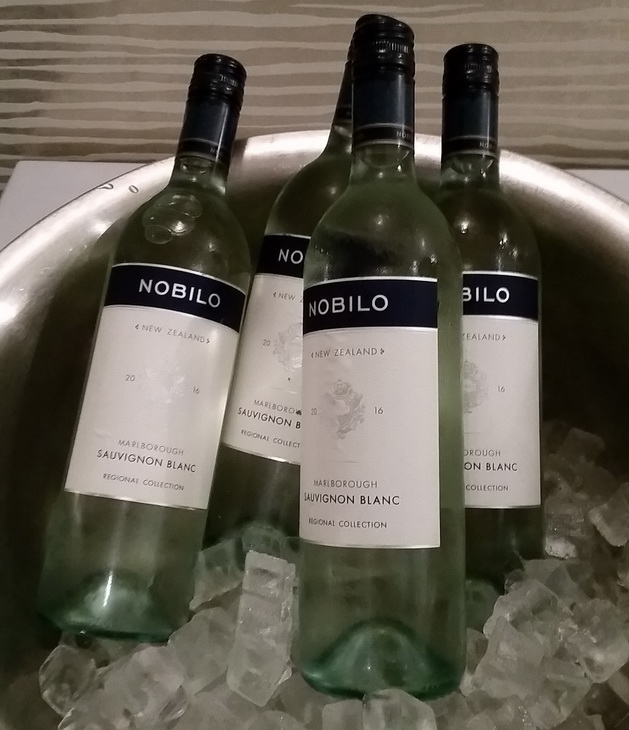
That said, when the second wine was served and I went back to my tacos, it was a match made in heaven, brought to you by the 2016 Nobilo Icon Sauvignon Blanc.
This wine is Dave’s baby, and you can practically taste the love that has gone into it. He describes it as “flinty minerality under delicious fruit”, but the texture of this wine is what got me. Usually a NZ sauvignon blanc is light and fresh, but this one was unctuous and elegant, with notes of pink grapefruit, peach, and white flower.
It did great things for the leftover heat of the jalapeño from the tacos, and also paired quite nicely with the exquisite tuna sashimi with yuzu marmalade that came as our second course.
Keep an eye out for this wine in Vintages in the next year. It is divine.
As Dave introduced the pinots that would accompany the third course, he mentioned that pinot noir grapes really have to be amazing to avoid being ripped out of the ground and replaced with the New Zealand wine industry’s bread and butter, sauvignon blanc. He is very proud of these grapes from the Waihopai Valley, whose hot days yield grape ripeness and fruit flavours, while the cool nights leave the grapes with a refreshing acidity.
For the third course, we were treated to a short vertical tasting of Nobilo’s Icon pinot noirs from 2013 and 2014, paired with Sidedoor’s delicious black cod with miso sake glaze. The dish was excellent (and I tend to use that term sparingly, so that’s a big deal), but it was taken to a whole new level when paired with the 2013 pinot noir.
This wine effused dark cherry and boysenberry as well as old world characteristics like earthiness, gamey notes, mushroom and forest floor. The old world characteristics matched the salty and umami flavours of the cod, which in turn brought out the more fruit-forward character of the wines. A delightful pairing!
A huge thanks to Dave Edmonds, the Constellation team, Natalie and of course Sidedoor for a fabulous event!
Nobilo Wines and Sidedoor fired their first shot of unusual pairings at us and wow did they deliver! Our first course comprised of two messy, juicy, tangy, and zesty pulled-peach-pork tacos paired with the Nobilo Regional Collection Sauvignon Blanc 2016.
Though these Sidedoor tacos demanded a couple napkins to get through them, they were absolutely worth rolling up your cuffs for and made all the better after a sip of Nobilo’s freshly bottled 2016 Regional Collection Sauvignon Blanc.
This Sauvignon Blanc itself, was a step away from the mainstream New Zealand hyper-herbaceous style. It’s fresh, it’s crisp, it has more developed tropical fruit notes than just the typical harsh green notes, and when paired with a juicy taco, it boosted its body and texture on the palate. Well done Nobilo!
Then came charging was course number two, a gorgeous plate of tuna sashimi w/ yuzu marmalade, pickled jalapenos and mustard seeds paired with the Nobilo Icon Sauvignon Blanc 2016. I was quite pleased with the first pairing but did not get the sense that it was indeed an “unusual one.”
This pairing, however, totally blasted my senses. With all the action going on around my plate of sashimi, I thought that there is hardly any way a New Zealand Sauvignon Blanc could improve this. But it did! The Icon Sauvignon Blanc shows off all the enticing crisp tropical fruit notes of the Regional Collection Sauvignon Blanc but with more texture, more weight, and a superbly balanced acidity. Outstanding Nobilo!
Nobilo and Sidedoor then launched a big one at us pairing a pan-fried black cod with black wood ear mushroom in a miso sake glaze and spiced dashi with the Nobilo Icon 2013 and 2014 Pinot Noir. This one intrigued me to no end.
The dish itself was my favourite of the bunch. Dominant flavours in this meal included salt and umami which moderately challenged these Pinot Noirs. Both wines upheld their silky smooth texture and concentrated cherry, smoke and spice flavours, but saw a drop in their mouth-watering acidity.
One thing to note here is that these Nobilo Pinot Noirs seem to be developing a juicy mouth-watering acidity as they age. When comparing them to classic Burgundian style, New Zealand Pinot Noirs carry a deeper ruby appearance, more red and black fruit aromas, a touch more tannins, and, sometimes, more alcohol.
This style tends to bury the acidity a bit. As they age, like 2013 Icon Pinot Noir, the fruit transformed from ripe flavours to earthy savoury notes and thus accentuating the acidity. So, was course number three an unworthy pair with the Icon Pinot Noir? Not at all! Texture and balance were very much present but, for my taste, I would like something with more acidity.
Finally, our last blast of unusual pairings brought us to a buttermilk pannacotta with lemon confit paired with the Nobilo Regional Collection 2016 Chardonnay. This one pretty much tanked for everyone because it was a touch too ambitious.
We provoke one of the cardinal rules of wine and food pairing, i.e. the wine must be sweeter than the dish. Nevertheless, this dessert was a scrumptious finish and the chardonnay was aromatic, flavourful and refreshing.
My path to discovering wine has been all about the discovery itself, so far. It’s an adventure exposing yourself to new wine experiences, and only so will you get to know yourself more. So, I highly recommend exploring and embracing a little taste of the extraordinary.
Pam Chiles
Wine & Food Blogger
Loads of fun and informative as usual, the Nobilo tasting with winemaker Dave Edmonds wound its way through an assortment of topics:
First Outings, Wild Pigs, Blind River Hills, Tight Harvests and Dave’s Babies. Sound random?
Not at all – funnily enough, it was all connected to wine. We tasted two Sauvignon Blancs, two Pinot Noirs and a Chardonnay from two collections – Regional and Icon.
We were honoured to be the audience for the “first outing” of the 2016 Icon Sauvignon Blanc – and what an impressive debut, indeed! Grapes for this wine come from a challenging growing area – the Blind River Hills.
Specialized equipment is necessary, as is a dedicated team tending the vines. The Icon is Dave’s self-proclaimed “baby”…although I believe he does have human children as well! I’m sure they don’t mind.
The Icon lives up to its name – a superb example of New Zealand Sauvignon Blanc.
People may be interested to know that in 2016 there was a drought in Marlborough (so we weren’t the only ones), perfect for Sauvignon Blanc, apparently. The harvest was “tight”, all-at-once, without the gradual build-up to the peak.
Dave was thrilled with the quality of the grapes, and it is reflected in the resulting product. Both 2016 Sauvignon Blancs are impressive.
Fun fact – New Zealand was apparently inhabited solely by birds until Europeans landed and brought their assorted four-legged beasts, including pigs (and sheep, as we all know). Dave likens the gaminess in the Pinot Noir to wild pig meat and invites us all to hunt with him – for pigs, that is, not Pinot, although one hopes for a glass as a reward at the end of the hunt?
I’m not sure I need to put that one on my bucket list, however. I’m content just to enjoy the gaminess in the wine, pigs not required. Both Pinots (vintages 2013 and 2014) showcased lovely ripe fruit and structure as well.
Cheers to the chef at Sidedoor Kitchen who came up with some marvellous, atypical pairings – a standout was the Tuna Sashimi with marmalade, jalapenos and mustard – it brought out some really remarkable earthy/umami flavours in the Icon Sauvignon Blanc.
Rachelle O’Connor
Wine Blogger & Judge
David Edmonds from Nobilo wines of New Zealand entertained us with his engaging conversation and exciting portfolio at Sidedoor restaurant in the Byward Market.
The menu was carefully chosen showcasing lots of local fare paired with some new vintages from the winery.
Hailing from the Wellington area of New Zealand, David gave us an inside view on what conditions were present in the last year, coupled with the unique terroir of some of New Zealand’s most recognized vineyards.
Dave Edmonds has been exposed to the wine industry his entire life – his parents were lovers of wine. On the weekends, as a child, he would tour the different wine regions with his parents and even recounts how family dinners were always accompanied by his glass of diluted wine.
His passion and knowledge grew from there. A Horticultural graduate – he sought out a career in the winemaking industry and has never looked back.
The Sauvignon Blanc Icon wine 2016 is “his baby” – he truly feels the magic that was created was a combination of the landscape and terroir of his favorite region – Blind River. He spoke about the excellent team that exists there and applauded their role in his achievements.
The Marlborough Region is well known for their outstanding Sauvignon Blancs and Pinot Noirs that the maritime climate is capable of producing. The 2016 year was no exception for Nobilo, as the weather was ideal.
New Zealand’s unique climate, coupled with the soil structure and the passion for the land is what contributes to New Zealand‘s world-renowned wines – and Nobilo showcases this very well managing to create beautiful wines from this place of outstanding grape-growing potential.
Sylvain Segard
Accredited Sommelier
On November 3, 2016, I took part in a food and wine pairing event at Ottawa’s Sidedoor, Contemporary Kitchen and Bar, featuring New Zealand’s Nobilo Wines.
The luncheon was lead by David Edmonds, Nobilo’s winemaker, who was introducing the Natalie MacLean wine writing team to their 2016 wine release.
We had the opportunity to sample the Nobilo Regional Collection Sauvignon Blanc 2016, the Nobilo Icon Sauvignon Blanc 2016, both a Nobilo Pinot Noir 2013 and 2014, and the lovely Nobilo Regional Collection Chardonnay 2016 (see http://www.nataliemaclean for my review of each wine).
These fragrant wines were paired with a selection of the Sidedoor’s tapas including, respectively, pulled peach pork tacos; tuna sashimi with yuzu marmelade and pickled jalapeños; black cod with miso glaze in spiced dashi broth; and, a buttermilk panna cotta with lemon confit. In my view, the best match was the sashimi with the Icon Sauvignon Blanc where the grapefruit pith and passion fruit of the wine was set off by the heat of the pickled jalapeños of the tender flash seared tuna.
However, the pleasant surprise was the matching of the dry Chardonnay with the light panna cotta. While it was unconventional to match a sweet dessert to a dry wine, the lemon candy in the dessert emphasized the tangerine and citrus rind character of the wine, and the acidity in the wine cleansed your palate of the panna cotta’s soft creaminess — leaving you wanting for more of both.
It was interesting to discover the winemaker’s passion in making the best expression of what the Sauvignon Blanc Nobilo’s terrior can produce. Intent on emphasizing the complex and aromatic tropical characters of New Zealand’s iconic grape varietal, we learned that Nobilo launched a structured research project to better understand which aspects of grape growing, wine making, and barrel ageing best emphasize the citrus rind, pineapple, passion fruit and other tropical flavours in their wines.
Similarly, they hope to improve their ability to control some of the ‘greeness’ that is often found in New Zealand’s Sauvignon Blanc, which in subtle amount can add good herbal complexity and fragrant notes, but in excess can taste like my mom’s overcooked green beans.
There is a bit of irony in the wine making trials that Nobilo is doing. Indeed, their Sauvignon Blanc project is inspired by vinification methods used in Chardonnay winemaking, to increase mouthfeel and aromatic complexity with the use of barrel ageing and malolactic fermentation.
Yet, Nobilo’s own Chardonnay is un-oaked and purposely vinified to express the Chardonnay grape in all is purity, crispness, and simplicity — kind of like what I have grown to love in New Zealand’s Sauvignon Blanc up to now.
In any event, I look forward to sampling the outcome of Nobilo’s research in their future vintages and releases of their superb Sauvignon Blanc.
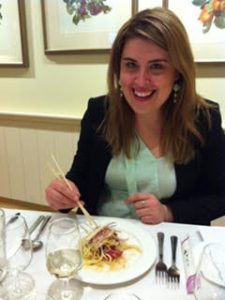 Camelia Bucar
Camelia Bucar
Certified Sommelier & Blogger
On November 3rd, on a raining day of autumn in downtown Ottawa at Sidedoor Restaurant, a group of enthusiastic wine lovers and sommeliers had once again an amazing experience involving a tasting of New Zealand wines. Despite the rain and cold, the ambiance in the restaurant and the menu that accompanied the tasting was extraordinary creating a warm and welcoming environment to be part of.
The title of the tasting was “Unusual Pairings with Sauvignon Blanc’’. I was very intrigued to find out what kind of pairing we will be doing considering that we had a previous Sauvignon Blanc experience not too long ago.
One month apart from the Kim Crawford wine tasting of Sauvignon Blanc from Marlborough region, we had the pleasure to meet Dave Edmonds, the winemaker behind the Nobilo brand, who was presenting his crafted Sauvignon Blanc from Marlborough region.
What was the most interesting part for me during this tasting was learning that Sauvignon Blanc can now be an option for dishes that are on the sweeter side such as Asian Thai food, pulled pork tacos or fish tacos and seafood based dishes. Usually, we recommend an off-dry Riesling for such dishes but having a Nobilo Regional Collection Sauvignon Blanc (2016) can be a great choice.

The aromas of tropical fruit (pineapple, mango, and passion fruit), stone fruit (white peaches) and subtle mineral notes played a good role in cleansing the palate with the first course which was a pulled peach pork tacos. The acidity of the SB cut through the fat of the pulled pork.
The sweetness of the peach complemented the tropical fruit of the SB. The lime and cilantro brought out the citrusy and vegetal note of the wine.
Overall, the Nobilo Regional Collection Sauvignon Blanc had balanced acidity and was juicier than a regular, harsh, and dry SB.
However, I must say the Nobilo Icon Sauvignon Blanc (2016) with the Second course, which was a tuna sashimi with yuzu marmalade, pickled jalapenos and mustard seed, was a match made in heaven.
This wine is the baby of Dave Edmonds. He was so proud to present this wine to us and we were honoured to have the pleasure of enjoying it in his company. Even though, we tasted another SB, this one had a completely different approach than the first one.
On the nose, there are aromas of citrus, gooseberries and vegetal notes (asparagus). On the palate, this full bodied Sauvignon Blanc is fresh with citrusy notes, white pepper and a long finish of gooseberries mixed with balanced acidity.
Our second course brought out the roundness and creamy texture of the wine. It embraces all the elements of this dish (sweet, spicy, salty and sour).
As for our third course, we had the opportunity to try out two different years of the Nobilo icon Pinot Noir (2013-2014), a bonus. The theme of “Unusual Pairings with Sauvignon Blanc’’ got extended with the presence of the Pinot Noir.
The third course consisted of a black cod with miso sake glaze & spiced dashi. The 2013 Pinot noir had aromas of dark cherries with oaky and spicy notes (French oak barrels). Smooth, good acidity and soft tannins complimented the black cod. However, the 2014 Pinot Noir is still a very youthful wine that has aging potential (5 more years before drinking it).
The 2014 wine has more fruits coming forward than the 2013. Aromas of dark cherries, oak and mocha notes. Very jammy wine, juicy, nice balanced acidity with well-integrated soft tannins. Out of the two options, the 2014 was the best pairing with the third course.
At the end, with our dessert of buttermilk panna cotta with lemon confit, we tried the Nobilo Regional Collection Chardonnay 2016. The Chardonnay had aromas of lemon, no oak and more mineral notes to it.
The dessert was too sweet for the Chardonnay which was overpowering the wine. A buttery Chardonnay would have been a more suitable option with the dessert. However, the Chardonnay was delightful on its own.
A huge thank you to Dave Edmonds for presenting his crafted work and to the Sidedoor Restaurant for a delicious menu.
Marlborough Sub-Regions
We have access to 1500 hectares of owned vineyards, and
1500 hectares of contract vineyards.
Importance of Blending for Sauvignon Blanc: (B)
Central Wairau / Rapaura:
Passion fruit, grapefruit, sweat
Lower Wairau
Pink grapefruit, mango and pineapple
Rarangi:
Pineapple and guava with subtle notes of mandarin, elegant
palate with juicey acidity
Southern Valleys:
floral notes with melon and stonefruit characters
Awatere:
Herbal, freshly cut nettles and tomato plant, big palate
Blind Valley:
Yellow grapefruit, passionfruit pith and broom flowers
Central Wairau / Rapaura
– Lighter stony soils are more likely to yield higher alcohols, greater
body and more of the greener nettles and tomato leaf characters
moving into grapefruit and a touch of broom, these are the core
Matador Estate characters.
– The heavier silts are capable of giving more of the lifted
aromatics described as grapefruit, passion fruit and sweet –
sweat with a touch of tomato leaf, these are the
Drylands/Giffords and Jones vineyard characters
– Variable alluvial soils from big river stones, to fine alluvial silt
– Consistent climate, moderately frost free
– Good diurnal variation, and good length of growing season
– Sea breezes in the mid-summer can drop temperatures by 5°C in
the afternoon
– Lower alcohols, more elegant
Lower Wairau /Rarangi
– Lower peak temperatures in summer
– Relatively warm, early ripening,
– Frost free, warm soils with a high water
table…young
– Two soil types. Coastal ‘pea gravels’ and deep
silts, divided by the Wairau diversion
– The soil is less of a driver than the cool, coastal
climate with a comparatively low diurnal range for
Marlborough
Awatere
– Close to the mountains, but by the sea
– Nor’West winds, regularly over 30mph. Less vigour,
more fruit development
– Low rainfall (40% less than Central Wairau) – reliance
on ex-river water rights
– Sunshine – heat summation over a longer period
– Less Spring frost risk due to turbulent katabatic air
movement
– Irrigation helps free draining alluvial soils hold enough
moisture for plant growth
Blind River
– Blind River is an exciting new region just south of the Awatere
Valley, one to five kilometres from the sea

– We have 56 hectares of Sauvignon Blanc planted here and
also source from local growers
– The Blind River Valley is notoriously dry and was long
overlooked for lack of water. Also the high concentration of
wind-blown loess forms a hard crust which has to be ripped up
before planting can start
– However, the vines blossomed as soon as irrigation from the
Awatere River came to the area in the early 21st century
– Our viticulturalists and winemakers are enthusiastic about the
different flavours which Blind River grapes bring to our blends.
Sometimes these are floral and generous. In other years, Blind
River surprises us with classical Marlborough notes we might
have expected from the Central Wairau or Awatere
Nobilo Regional Collection Sauvignon Blanc 2016
Marlborough, New Zealand
Nobilo Icon Sauvignon Blanc 2016
Marlborough, South Island, New Zealand
Nobilo Icon Pinot Noir 2013
Marlborough, New Zealand
Nobilo Icon Pinot Noir 2014
Marlborough, New Zealand
Nobilo Regional Collection Chardonnay 2016
Marlborough, New Zealand
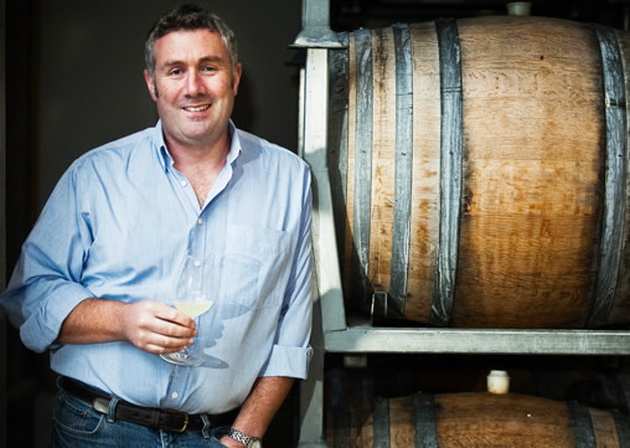 Nobilo Wines Chief Winemaker, Dave Edmonds
Nobilo Wines Chief Winemaker, Dave Edmonds
David Edmonds was born in Wellington, New Zealand the same year the first Sauvignon Blanc vines were planted in Marlborough. As a child, David spent a lot of time visiting the wine district just north of Wellington with his parents. It was during those family outings in which is his interest in grape-growing and winemaking took root.
After earning a degree in horticulture science at Christchurch’s Lincoln University, Dave headed up to Hawke’s Bay on the North Island for his first vintage. He still wasn’t quite sure whether he wanted to pursue viticulture or winemaking; by lunchtime on his first day, though, he was hooked on winemaking.
David joined Nobilo in 2002 and his passion is Marlborough Sauvignon Blanc. He has developed a personal connection and in-depth knowledge of the flavour profiles of Nobilo vineyards throughout the region.
“I’ve always been drawn to Sauvignon Blanc’s capacity to bring the palate alive. I’m also convinced the tools for making wines of complexity and depth have never been greater—my mission is to unlock the possibilities still undiscovered!”



